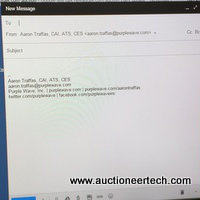There was a discussion on Facebook a while back about what is and what isn’t appropriate to include in an email signature. It’s so easy, yet many auctioneers fail at creating a signature that is simple and professional. Let’s take a look at what we should include, what we should omit and how we should present our email signatures.
Include
Your email signature should be used sparingly to brand yourself and your company. Make it easy for someone to, at a glance, know who you are, what you do and how to contact you. The first line should always be your name and professional designations. You paid money for these designations, and your email signature is a perfect opportunity to leverage them to potential customers – everyone you communicate with should be considered a potential customer.
Directly below your name and designations should be your email address. That’s the most relevant contact method, since we’re talking about email to begin with, so that’s what the person you’re corresponding with should see first. Some people might argue that it’s not necessary, but if you’ve branded yourself properly, your email address should include your website and it’s a great opportunity for a branding impression. If you have a mobile phone number that you want to include, it should tag along with your name and email address here.
Company information comes next. I like to separate the company block from the personal block with a blank line. Include your firm’s name and, if you need your mailing address, you can include it, too. I think the physical address adds extra weight to the signature and is rarely needed, so I omit it, but I can’t fault someone for including a company address. Your company’s public phone number and website address go next.
You can include social media links, but only include links – never icons – and make sure to include only links to profiles that are active. Don’t include a link to your YouTube page unless you offer value there and post frequent videos. Just because you have a social media presence somewhere doesn’t give you license to include it in your email signature.
Omit
Never include images in your email signature. Don’t do it. Ever. I don’t want to have to click the extra button in my email client to display images that I think might be relevant to the conversation, only to find out that it’s your company logo or, worse, social media icons. Also don’t include a vCard. It causes the same problem as images, but is even more arduous to deal with.
It’s not necessary to include patronizing labels for the components of your signature. We know what a website looks like; we know what a phone number looks like. You don’t need to label what they are in your signature. The possible exception is disambiguating a fax number from a phone number, but if you’re including a fax number in your signature you need to have a long conversation with yourself about what decade you’re living in.
Don’t include a quote. You might have a saying that feels good to you, but its rare that an inspirational quote won’t offend someone somewhere. It’s usually me, so leave it out. It’s unnecessary and unprofessional.
Leave out the confidentiality notice. Every article I’ve ever read about confidentiality notices in email signatures says that they’re not enforceable. Why add all the extra garbage that nobody reads or cares about?
Lastly, leave out the stock closing message. Including “Thanks,” or “Cheers,” or “Respects,” as the first line of the signature to make it look like you typed it works only the first time. The second email in an exchange will out you as simply lazy.
Professional presentation
Stay away from HTML. I’ve railed for years on the benefit of plain text email for bulk email newsletters, and we can argue about the benefits of pictures and fonts for advertising and marketing purposes, but when it comes to correspondence between two people, there’s absolutely no call for HTML email. It’s simply unprofessional and adds junk that can only take focus away from the conversation. Fonts and colors have no place in email.
Use plain text to arrange your signature in such a way that it’s easy to read and takes up as few lines of vertical space as possible. I like to use the pipe as a way to include more than one piece of information on the same line, but make sure to keep the number of characters per line under 72 so it doesn’t break in weird places. As an example of pipe usage, here’s my personal three-line signature, which includes my name, email address, two social media accounts and three websites. Remember that pretty much all email clients will turn the plain-text links into the active, clickable links.
Aaron | twitter.com/Traffas
[email protected] | facebook.com/traffas
aarontraffas.com | aarontraffasband.com | auctioneertech.com
Here’s my professional signature which includes my name, designations, company name, website, profile page and two social media accounts. We have many more social media presences, but someone interested in me or the company can learn everything possible from the few links I’ve included in my signature.
Aaron Traffas, CAI, ATS, CES
[email protected]
Purple Wave, Inc. | purplewave.com | purplewave.com/aarontraffas
twitter.com/purplewave | facebook.com/purplewaveinc
In summary, a professional email signature is simple and short, doesn’t include images or formatting, and contains just the right amount of appropriate information.
